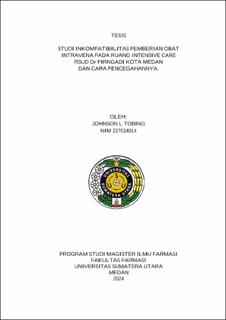Studi Inkompatibilitas Pemberian Obat Intravena pada Ruang Intensive Care RSUD Dr Pirngadi Kota Medan dan Cara Pencegahannya
Study on Incompatibility of Intra Vena Drug Administration in the Intensive Care Unit RSUD Dr Pirngadi Kota Medan and Hot to Prevent

Date
2024Author
Tobing, Johnson L
Advisor(s)
Bangun, Hakim
Arianto, Anayanti
Metadata
Show full item recordAbstract
Background: Prescribing and administering intravenous (IV) injection drug therapy to patients in hospitals is increasing to achieve immediate pharmacological effects but can have a high risk of drug incompatibility so that it requires special attention if the drug must be given for therapeutic purposes or substitution purposes with the same therapeutic class.
Objective : Identifying incompatibility pairs of IV injection drugs in the intensive care unit (ICU) of RSUD Dr Pirngadi Kota Medan and prevention
Methods : Retrospective survey of electronic prescribing (e-prescribing) incompatibility of IV injection drugs in the ICU using the Lexicomp® application. In vitro incompatibility testing in one container, in vitro incompatibility testing simulation using y-site with treatment without or with flushing before and after administration of bolus-bolus or bolus-infusion as well as the use of a multilumen central venous catheter (CVC) by observing the formation of sediment, bubbles/gas, color change, turbidity value, pH value and particle size
Results: From the results of the Retrospective identification of Electronic Prescriptions for the period January 2022 to May 2023, data on the number of patients was 165 people, consisting of 91 people who received compatible prescriptions and 74 patients who received incompatible prescriptions. The number of IV injection drugs used was 60 item with the number of incompatible drug pairs being 102 pairs and the frequency of incompatibility being 303. In the in vitro incompatibility testing simulation of pairs of incompatible IV injection drugs in one container, the in vitro incompatibility testing simulation of incompatible drug pairs used multi y-site one way on a double lumen CVC without flushing obtained drug incompatibility data, when using a two-way multi y-site on a three-lumen CVC with flushing treatment before and after administration of bolus-bolus or bolus-infusion, drug incompatibility prevention data was obtained.
Conclusion: Identification of patient electronic prescribing is still found in patients receiving incompatible pairs of drugs and the use of multi y-site with flushing treatment before and after administration of bolus-bolus and bolus-infusion as well as the use of two-line CVC three lumen can prevent the occurrence of incompatible drugs
Collections
- Magister Theses [356]
